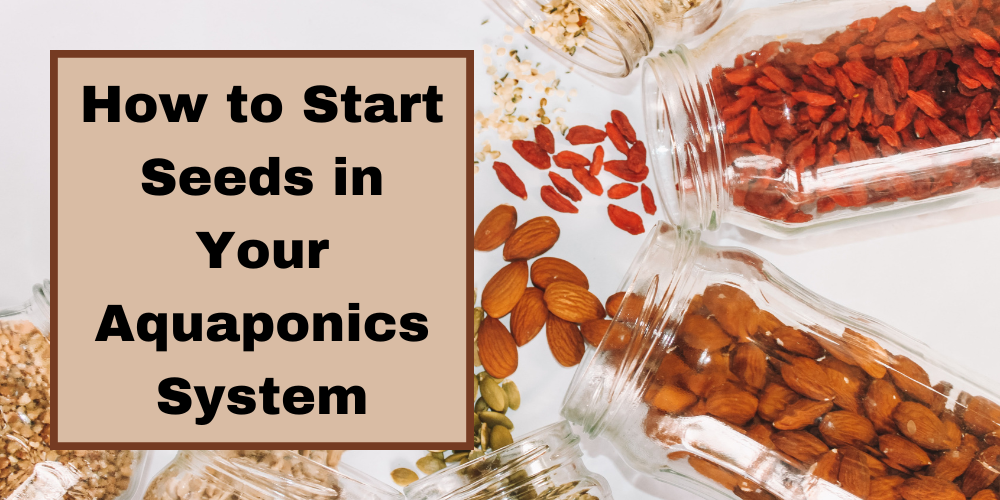While aquaponics is often praised for being a low-maintenance growing method, that doesn't mean "no maintenance." Overlooking regular fish maintenance tasks, even something as simple as checking ammonia levels or watching for signs of stress, can quickly lead to system imbalances, sick fish, or worse, a complete crash.
The good news? Most problems can be prevented with a straightforward weekly, monthly, and seasonal routine that takes just a few minutes a day or week. This guide will walk you through:
- Essential weekly and monthly fish care tasks
- Seasonal adjustments for temperature, feeding, and water conditions
- How to spot early signs of fish stress or disease
- The tools you need to monitor and maintain optimal fish health
Whether you're raising tilapia, trout, catfish, or koi, this blog will help you keep your fish happy, your plants healthy, and your system thriving year-round.
Why Consistent Fish Maintenance Matters in Aquaponics
In aquaponics, your fish are the engine of the entire ecosystem. Without healthy, well-cared-for fish producing waste, your plants wouldn’t receive the nutrients they need to grow. That’s why consistent maintenance isn’t just recommended, it’s essential.
Neglecting fish care can result in:
- Ammonia or nitrite spikes that stress or kill fish
- Diseased or injured fish that spread infection in the tank
- Imbalanced biofilters, reducing nutrient availability to plants
- Overfeeding problems, leading to cloudy water and anaerobic zones
- Overstocking of fish which can leadto rapid ammonia accumulation, while understocking can leave your plants undernourished
Worse yet, once a problem begins, it often spirals. For example, a drop in dissolved oxygen can stress fish, making them more susceptible to disease, which leads to uneaten food, which further worsens water quality.

Weekly Fish Maintenance Tasks
Weekly tasks are the foundation of successful aquaponic fish care. These small but critical checks help you catch problems early and keep your fish thriving in a stable, stress-free environment.
Here’s a checklist of what to do each week:
1. Test Water Parameters
Monitoring your water quality should be your top weekly priority. Test for the following:
- Ammonia:Ideal range is 0 ppm
- Nitrite: Ideal range is 0 ppm
- Nitrate: Ideal range is 5-40 ppm ( depanding on the number of plants)
- pH: Ideal range is 6.8-7.2 (dependind on the fish and plants_
-
Temperature:Depends on the fish
Use a reliable aquaponics water testing kit or digital meter. Log results in a notebook or spreadsheet to track trends and catch imbalances before they become emergencies.
2. Visually Inspect Fish
Spend 1–2 minutes to watch and observe the behavior of your fish. This is often the first line of defense for spotting problems. Look for:
- Changes in swimming behavior (e.g., sluggish, erratic, flashing)
- Visible issues like fin rot, white spots, red gills, or clamped fins
- Fish gasping at the surface or hiding constantly
Behavioral changes are usually linked to water quality issues or early-stage disease. Catching them now can save your whole tank.
3. Feed, Observe, and Remove Leftovers
- Feed 1–2 times daily based on species and size
- Only feed what fish can eat in 2–3 minutes
- Remove uneaten food after 15 minutes to prevent water contamination
- Watch for loss of appetite (a red flag)
Tip: Feeding is also a great time to observe fish behavior and check for injuries or disease signs.
4. Check and Clean Filters (Lightly)
Do a quick rinse of mechanical filters (like foam or mesh) if you notice reduced water flow. Don’t over-clean biological filters as they house beneficial bacteria essential for nutrient cycling.
5. Top Off Water Levels
Due to evaporation, you’ll likely need to top off the water weekly with dechlorinated or rain water. This keeps water levels stable for pumps and helps maintain fish comfort.
6. Check Equipment Function
Make sure your system is running smoothly:
- Air stones bubbling?
- Pump flowing steadily?
- No clogs in pipes or overflows?
- Backup power system tested?
Monthly Fish Maintenance Tasks
While weekly maintenance keeps things running smoothly, your monthly tasks go deeper. This is your chance to clean, calibrate, and inspect key components of the system that affect both fish health and system performance.
Here’s what to include in your monthly aquaponics routine:
1. Deep Clean Mechanical Filters
Unlike weekly rinses, your monthly clean is more thorough:
- Disassemble filter pads, mesh screens, or swirl filters
- Scrub off any sludge or biofilm buildup
- Rinse with tank water (never tap water) to preserve beneficial bacteria
2. Inspect Plumbing and Flow Rates
Over time, algae, bio-slime, or solids can build up in pipes and fittings:
- Check for reduced flow to and from tanks
- Clear out any blockages or clogs
- Test water flow through grow beds and sump
Steady flow is critical to maintain oxygen levels and prevent dead zones in your system.
3. Calibrate Meters and Probes
Your digital tools lose accuracy over time. Once a month:
- Calibrate pH meters, digital thermometers, and EC/TDS meters (if used)
- Check battery levels
- Clean any sensors or probes
4. Measure Fish Growth & Stocking Density
Track the size and weight of your fish to:
- Ensure they’re growing at a healthy rate
- Avoid overcrowding, which can lead to oxygen depletion and increased ammonia
- Plan for harvesting, thinning, or rehomin
Tip: Use a soft mesh net and a tared bowl on a scale for safe, fast fish weighing.
5. Examine Biofilter Health
While you don’t want to disrupt your biofilter, do a visual check for:
- Unusual smells (rotten = anaerobic = bad)
- Excess sludge or clogging
- Consistent water flow
6. Clean Tank Surfaces and Equipment
Use a soft sponge or algae scraper to clean tank walls (especially where sunlight hits), and inspect:
- Air stones for calcium or debris buildup
- Pump inlets for clogging
- Floating solids near tank corners
Seasonal Aquaponics Fish Care Tasks
Every season brings unique challenges and opportunities for your aquaponics system, especially for your fish. From water temperature swings to feeding shifts and disease risks, your fish care routine needs to adapt throughout the year.
Let’s break it down season by season:
1. Spring: System Wake-Up and Growth Boost
Spring signals the return of warmth and active growth, for both fish and plants.
Key Tasks:
- Resume full feeding as water temps rise
- Monitor ammonia/nitrite spikes due to increased metabolism
- Check for spring disease outbreaks like parasites or bacterial infections
- Clean tanks and restart any components paused over winter
Tips:
- Slowly adjust feeding volume over 1–2 weeks to avoid shocking your system
- Consider a low-dose salt treatment (1–2 ppt) to help fish recover from winter stress
- Test water more frequently during seasonal transitions
2. Summer: Managing Heat and Oxygen Levels
Summer can stress your system with high temps, low oxygen, and faster waste production.
Key Tasks:
- Monitor water temperature daily (optimum range varies by species)
- Increase aeration using extra air stones or pumps
- Add shade cloth or cover tanks to reduce solar gain
- Watch for algae blooms and cloudy water
- Check DO (dissolved oxygen) levels, especially in early morning
Tips:
- Feed early morning or evening to reduce oxygen competition
- Use water coolers or circulation techniques in extreme climates
- Ensure fish aren’t gasping or clustering near aerators
3. Fall: Transition and Pre-Winter Prep
Fall is the time to gradually slow things down and prepare fish (and your system) for the cold.
Key Tasks:
- Slowly reduce feeding as water temps drop
- Begin planning for overwintering or harvesting
- Check and insulate plumbing, tanks, and grow beds
- Do a full system inspection before freezing conditions hit
Tips:
- Start reducing feed when temps fall below 65°F (18°C) for warm-water species
- Reassess tank volume and stocking if moving fish indoors
- Consider removing non-hardy species or fingerlings for overwintering
4. Winter: Cold Weather Care and Survival
Cold weather is one of the most dangerous times for aquaponic fish, especially in temperate climates.
Key Tasks:
- Keep water within safe temperature ranges using heaters or insulation
- Reduce or suspend feeding depending on species (e.g., tilapia stop eating < 55°F / 13°C)
- Check aeration often, cold water holds more oxygen, but fish may still be stressed
- Watch for sluggish behavior, fin clamping, or surface gasping
Tips:
- Use tank heaters, tank blankets, or greenhouse systems to retain warmth
- Monitor water daily even if feeding stops
- Keep emergency power backup ready, fish loss from sudden freezing is common

Common Fish Health Problems & Troubleshooting
Even with the best maintenance, fish can face health challenges. Early identification and prompt action are key to preventing small problems from becoming system-wide disasters.
Here are some of the most common issues and how to troubleshoot them:
1. Fish Gasping at the Surface
Cause:Low dissolved oxygen (DO) or high ammonia levels
Signs: Fish crowd near surface, gulping air
Troubleshooting:
- Check aeration equipment (air stones, pumps) immediately
- Test water for ammonia, nitrite, nitrate, and DO
- Increase aeration, reduce feeding temporarily
- Perform partial water changes if needed
2. Flashing or Scratching Behavior
Cause:Parasites or irritants in water
Signs:Fish rubbing against tank surfaces, flashing fins
Troubleshooting:
- Inspect water quality (ammonia spikes can cause irritation)
- Quarantine affected fish if possible
- Treat with approved anti-parasitic medication safe for aquaponics
- Maintain excellent water quality to prevent recurrence
3. Fin Rot and Fungal Infections
Cause: Bacterial infection due to stress or injury
Signs: Torn, ragged fins; white fuzzy patches
Troubleshooting:
- Improve water quality and reduce stress factors
- Isolate infected fish if possible
- Use natural remedies or aquaponics-safe antibiotics carefully
- Check for sharp objects in tank causing injury
4. Loss of Appetite or Lethargy
Cause:Poor water conditions, disease, or temperature stress
Signs: Fish not eating, hiding, or resting at tank bottom
Troubleshooting:
- Test water parameters and adjust as needed
- Ensure water temperature is within species-specific range
- Examine fish for visible signs of disease
- Consider quarantine and treatment if symptoms persist
5. Cloudy or Smelly Water
Cause:Overfeeding, poor filtration, or bacterial bloom
Signs:Turbid water, unpleasant odor
Troubleshooting:
- Reduce feeding amounts
- Clean mechanical filters and inspect biofilter health
- Increase aeration and perform partial water changes
- Avoid overstocking
General Troubleshooting Tips:
- Keep a fish health log:Note symptoms, water test results, and treatments
- Quarantine new fish:Prevent introducing diseases to your system
- Avoid chemical treatments: Many can harm beneficial bacteria; use aquaponics-safe options
- Consult experts or forums:Sometimes, symptoms require professional advice
Tools and Supplies for Effective Fish Maintenance
Proper tools and supplies make fish care easier, more accurate, and more efficient. Investing in quality equipment can save you time, reduce stress on your fish, and help maintain a balanced aquaponics ecosystem.
Here are the essential tools every aquaponics gardener should have:
1. Water Testing Kits and Meters
- Comprehensive Water Test Kits:Look for kits that measure ammonia, nitrite, nitrate, pH, and hardness.
-
Digital Meters: pH meters, TDS (Total Dissolved Solids) meters, and dissolved oxygen meters provide precise real-time data.
- Calibration Solutions:Ensure you regularly calibrate your digital meters for accuracy.
-
Why it matters:Accurate and frequent water testing is key to spotting imbalances before they harm your fish.
2. Aeration Equipment
- Air Pumps and Air Stones: Maintain healthy oxygen levels for fish and beneficial bacteria.
- Backup Air Systems:Consider battery-powered or solar backup pumps for power outages.
-
Why it matters:Oxygen-rich water reduces fish stress and supports aerobic bacteria vital for nutrient cycling.
3. Feeding Tools
- Automatic Fish Feeders:Useful for consistent feeding, especially when you’re away.
- Hand Feeding Spoons or Cups:For small or targeted feedings.
- High-Quality Fish Food: Species-specific pellets or flakes with balanced nutrients.
-
Why it matters: Proper feeding tools and nutrition promote fish growth and health without overfeeding.
4. Cleaning Supplies
- Soft Brushes and Algae Scrapers:For gentle tank wall cleaning without harming fish.
- Nets:Soft, fine-mesh nets for safely catching and moving fish.
- Buckets and Siphons:For water changes and debris removal.
-
Why it matters: Regular cleaning prevents disease and keeps water clear without disrupting the system.
5. Monitoring and Logging Tools
- Notebooks or Digital Logs: Track water parameters, feeding, fish behavior, and maintenance tasks.
- Mobile Apps:Some apps specialize in aquaponics or fish farming data management.
-
Why it matters: Keeping records helps detect patterns, troubleshoot problems, and improve your system over time.
6. Backup and Emergency Supplies
- Spare Pumps and Air Stones:For quick replacements if equipment fails.
- Dechlorinator:For preparing fresh water additions.
- Water Conditioners: To neutralize harmful compounds in water if needed.
-
Why it matters:Being prepared minimizes downtime and reduces risks during unexpected system issues.
Best Practices and Tips for Long-Term Success
Mastering fish maintenance in aquaponics isn’t just about following a checklist, it’s about cultivating a deep understanding of your system and building habits that ensure lasting health and productivity.
Here are some expert tips to help your aquaponics system thrive:
1. Stay Consistent but Flexible
- Maintain your weekly, monthly, and seasonal routines religiously.
- Adapt your practices based on fish species, system size, and local climate changes.
- Keep a detailed maintenance log to track what works and what doesn’t.
2. Prioritize Water Quality
- Regularly test and adjust water parameters to keep fish in their optimal ranges.
- Avoid sudden changes in temperature, pH, or chemical levels.
- Use high-quality water sources and always dechlorinate new water.
3. Monitor Fish Behavior Daily
- Early signs of stress or illness can be subtle.
- Spend a few minutes each day observing your fish for changes in appetite, swimming patterns, and physical appearance.
- Prompt action at the first sign of trouble saves time and fish lives.
4. Balance Your System Holistically
- Remember, fish, plants, bacteria, and equipment form an interdependent ecosystem.
- Adjust stocking density, feeding, and plant load in harmony.
- Avoid overcrowding and overfeeding, both stress fish and damage water quality.
5. Prepare for Emergencies
- Have backup equipment ready for pumps, aerators, and filters.
-
Develop a contingency plan for power outages, disease outbreaks, and extreme weather.
6. Keep Learning and Engaging
- Aquaponics is a dynamic field, stay updated with new research and community insights.
- Join local or online aquaponics groups for support and advice.
- Experiment carefully with new species, feeds, or system tweaks.
Conclusion
Maintaining healthy fish is essential for any successful aquaponics system. By staying on top of your weekly, monthly, and seasonal fish care tasks, monitoring water quality, and responding quickly to any signs of trouble, you set the stage for a thriving, balanced ecosystem that supports both robust fish and flourishing plants.
Remember, aquaponics is a rewarding journey that combines patience, observation, and continuous learning. To deepen your understanding and accelerate your success, consider investing in expert-led resources.
One highly recommended resource is Sylvia Bernstein’s comprehensive Aquaponics Gardening course on Udemy. Sylvia is a leading voice in aquaponics education, and her video course walks you through the entire process from system setup to ongoing fish and plant care, with clear, practical guidance that’s perfect for beginners and seasoned growers alike.
Ready to take your aquaponics skills to the next level?
Check out Sylvia Bernstein’s Aquaponics Gardening course on Udemy and start growing a thriving aquaponics system today!







Leave a comment (all fields required)